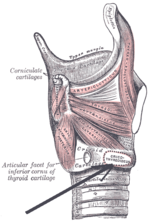 | The posterior cricoarytenoid muscle is a (bilaterally paired) intrinsic muscle of the larynx. It arises from the cricoid cartilage; it inserts onto the... 8 KB (872 words) - 17:43, 4 May 2024 |
 | The lateral cricoarytenoid (also anterior cricoarytenoid) is an intrinsic muscle of the larynx. It attaches at the cricoid cartilage anteriorly, and at... 4 KB (334 words) - 17:44, 4 May 2024 |
 | Larynx (redirect from Laryngeal muscles) muscles are the posterior cricoarytenoid muscles. The phonatory muscles are divided into adductors (lateral cricoarytenoid muscles, arytenoid muscles)... 35 KB (4,150 words) - 07:34, 10 May 2024 |
 | List of abductors of the human body (category Abductors (muscles)) the foot vocal folds Posterior cricoarytenoid muscle eyeball Lateral rectus muscle Superior oblique muscle Inferior oblique muscle Shoulder Articulations... 2 KB (149 words) - 16:00, 19 March 2023 |
 | attachments for the cricothyroid muscle, posterior cricoarytenoid muscle and lateral cricoarytenoid muscle muscles, cartilages, and ligaments involved... 10 KB (1,196 words) - 16:11, 11 February 2024 |
cartilage interarytenoid muscles (fold adduction) posterior cricoarytenoid muscle (fold abduction) lateral cricoarytenoid muscle (fold shortening/stiffening)... 40 KB (5,267 words) - 04:46, 21 March 2024 |
tract posterior commissure posterior communicating artery posterior cranial fossa posterior cricoarytenoid muscle posterior cruciate ligament posterior ethmoidal... 55 KB (4,460 words) - 12:06, 6 May 2024 |
superior longitudinal muscle elevates the apex of the tongue to make contact with the hard palate and the bolus is propelled to the posterior portion of the... 17 KB (2,244 words) - 21:13, 18 March 2024 |
Arytenoid adduction (section Posterior glottal gap) paralysis. A suture is used to emulate the action of the lateral cricoarytenoid muscle and position the paralyzed vocal cord closer to the midline. This... 10 KB (1,258 words) - 21:57, 14 August 2023 |
occur in the single abductor muscle of the vocal folds, called the posterior cricoarytenoid. The vocal folds cannot vibrate when they are open. The open position... 48 KB (5,091 words) - 20:59, 8 May 2024 |
where there is anterior dislocation of the arytenoid cartilage. In cricoarytenoid joint ankylosis where there is failed arytenoid adduction. The main... 12 KB (1,316 words) - 13:25, 5 November 2022 |
of the vocal fold may also result from mechanical breakdown of the cricoarytenoid joint. It was first described in by Kashima in 1989. Bilateral abductor... 10 KB (1,343 words) - 21:28, 4 August 2023 |
 | the two convex articular surfaces on the cricoid cartilage (at the cricoarytenoid articulations), the vocal processes are brought closer to each other... 3 KB (346 words) - 18:17, 5 November 2022 |
like Guillain–Barré syndrome or myasthenia gravis. The posterior cricoarytenoid (PCA) is a muscle of the larynx that is responsible for pulling the vocal... 37 KB (4,229 words) - 19:09, 4 November 2023 |
which widens the opening of the throat by activating the Posterior cricoarytenoid (PCA) muscle. Endoscopic feedback can also be used to show a patient... 32 KB (3,631 words) - 02:54, 12 October 2023 |







